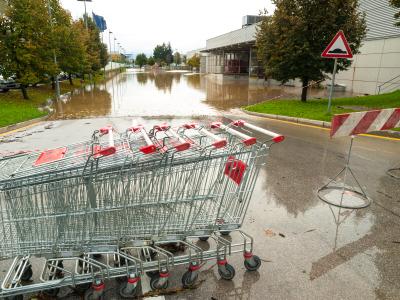 When a flood strikes a business, the damage it causes comes from more than the initial deluge.
When a flood strikes a business, the damage it causes comes from more than the initial deluge.
On top of wiping out inventories and destroying equipment, a flood disrupts normal business operations that are key to staying financially afloat.
Since most standard commercial property insurance polices don’t cover flooding, it’s important for any sized business to consider a separate flood insurance policy, according to the Insurance Information Institute.
“Ninety percent of all natural disasters involve flooding. Hurricane Sandy is simply the most recent and tragic example,” Loretta Worters, vice president with the I.I.I., said in a statement. “From 2007 to 2011, the average commercial flood claim was over $75,000; a substantial amount of money for a business to have to come up with on their own.”
Nearly 40 percent of small businesses never reopen their doors following a disaster because just a few inches of water can cause tens of thousands of dollars in damage, the National Flood Insurance Program reports.
After Hurricane Sandy struck in October 2012, entire businesses were wiped out. Alhough the final figures are not yet in, Sandy produced billions in flood losses to businesses, according to the I.I.I.
Coverage for flood-caused damage to a business is available from private insurance companies and from the federal government. Although many companies purchase commercial flood insurance through the private market, more business owners are now inquiring about purchasing additional NIFP coverage through the Federal Emergency Management Agency.
When used in tandem, NFIP coverage can mitigate or “buy down” large deductibles associated with commercial flood policies or simply provide additional coverage.
For small business owners, flood coverage is available as an endorsement to a Business Owners Policy, available through some private insurance companies, if the business is located outside a flood zone. Flood insurance for small businesses is also available from the NFIP.
The first step in securing flood insurance is to contact your insurance professional to discuss the specific needs of a business and the coverage options available.
A standard commercial flood insurance policy covers direct physical losses caused by flood as well as losses resulting from flood-related erosion caused by heavy or prolonged rain, coastal storm surge, snow melt, blocked storm drainage systems and levee or dam failure.
The I.I.I. offers four key strategies for protecting a business during flood season:
Check with local government offices or commercial bank to see if your business is located in a flood zone. Ask around to find out whether a location has been flooded in the past. Knowing if a property is in a floodplain is critical to keeping people and property safe during a storm, as well as to properly insure the property. Be aware that the NFIP is rolling out newly updated flood maps that will significantly expand flood zones in many parts of the country. Business owners should not assume that just because you were not in a flood zone last year you will not be in one today.
Consider buying flood insurance. Flood insurance premiums are calculated based on a number of factors in addition to the flood risk to the structure, such as the year the building was constructed, building occupancy, number of floors, the location of the contents, the deductible chosen, and the amount of building and contents coverage a policyholder has purchased, among other things. If a commercial property is in a high-risk flood area and a business owner has a mortgage from a federally regulated or insured lender, they’re required to purchase a flood insurance policy. Even on leased properties, business owners should consider purchasing flood insurance to cover any improvements made.
Include comprehensive coverage for commercial or fleet vehicles. Flood damage to commercial vehicles is covered under the optional comprehensive portion of a standard commercial auto insurance policy.
Don’t wait. While some areas are more prone to flooding than others, no place is completely immune. Even in high-risk areas, many business owners wait until a flood is imminent before considering a flood insurance policy. There is typically a 30-day waiting period from the date of purchase before a new NFIP policy goes into effect, so waiting until the last minute could leave you without flood coverage altogether.
“Businesses should always talk with their insurance professional regarding their flood risk and how to protect against it,” Worters said.












